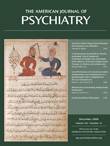Comment on “What Happened to Lithium?: Antidepressant Augmentation in Clinical Settings”
To the Editor: I am very surprised at the article by Marcia Valenstein, M.D., M.S., et al. (1) showing that only 1,106 (0.5%) of 244,855 patients with depression received lithium augmentation. On the other hand, the most popular augmenting drugs were a second antidepressant and a second-generation antipsychotic, received by 26,739 (11%) and 17,797 (7%) patients, respectively. Moreover, 9,053 (4%) patients received augmentation with anticonvulsants, while 11,054 (5%) received other augmenting drugs, such as thyroid hormone, stimulants, and buspirone.
Taking strong evidence for lithium as an augmenting drug of refractory depression (2) into consideration, I cannot accept the findings by Dr. Valenstein et al. (1) as they are. At least two possibilities are yet to be investigated. The first possibility is that most patients receiving lithium had been apparently and/or automatically diagnosed as suffering from bipolar disorder, which was excluded from their subjects. Because, according to Food and Drug Administration, lithium is indicated in the treatment of manic episodes of manic-depressive illness (i.e., bipolar disorder) and in maintenance therapy of bipolar disorder, but not in augmentation therapy for depression. Therefore, many patients actually receiving lithium augmentation for refractory depression might have been excluded from their analysis. The second possibility is that a significant proportion of patients had discontinued lithium augmentation within 60 days because lithium augmentation can bring about rapid responses in some patients (3) . They also might have been excluded from the subjects.
1. Valenstein M, McCarthy JF, Austin KL, Greden JF, Young EA, Blow FC: What happened to lithium?: antidepressant augmentation in clinical settings. Am J Psychiatry 2006; 163: 1219–1225Google Scholar
2. Bauer M, Dopfmer S: Lithium augmentation in treatment-resistant depression: meta-analysis of placebo-controlled studies. J Clin Psychopharmacol 1999; 19: 427–434Google Scholar
3. de Montigny C, Cournoyer G, Morissette R, Langois R, Caille G: Lithium carbonate addition in tricyclic antidepressant-resistant unipolar depression: correlations with the neurobiologic actions of tricyclic antidepressant drugs and lithium ion on the serotonin system. Arch Gen Psychiatry 1983; 40:1327–34Google Scholar



